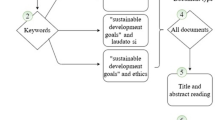Abstract
In September 2015, world leaders adopted a set of 17 Sustainable Development Goals (SDGs) to end poverty, fight inequality and injustice, and tackle climate change by 2030. The SDGs were built upon the earlier Millennium Development Goals (MDGs) and aim to achieve universal progress without leaving anyone behind. While the SDGs provide a glorious framework for espousing development for all peoples, identifying specific nuances regarding “development” needs to be identified to contextualize the accomplishment of the SDGs, especially in the case of Asia, a multi-ethnic and highly biodiverse region. In understanding these development nuances, this chapter explores an analogy between recent and international development efforts with missionary activities initiated by American Episcopal missionaries in Sagada, northern Philippines , during the early-to-middle twentieth century. As an indigenous community , certain aspects of Sagada culture allow natives to interact harmoniously with their ecosystems in a distinct culture–environment nexus. For instance, indigenous values indicate land and water bodies as places which should be dealt with care if to avoid being a receiver of some sort of paranormal retribution. Undoubtedly, the indigenous religion, cultural, and social arrangements have enabled Sagada folk to sustain their landscapes and natural resources into the modern world amidst culture changing arrangements introduced by American Episcopal missionary works. On the other hand, unfavourable effects have been inevitable and thus need to be emphasized in order to sustain growth beyond SDGs.
Access this chapter
Tax calculation will be finalised at checkout
Purchases are for personal use only
Similar content being viewed by others
References
Brent, C. H. (1906). A missionary sawmill. The Spirit of Missions, 71(10), 837–839.
CDP. (2015, June). Transitioning from the MDGs to the SDGs: Accountability for the post-2015 era. CDP Background Paper No. 25, ST/ESA/2015/CDP/25. United Nations Committee for Development Policy.
de Leon, F. M. (2011). In focus: Culture in development planning. Philippine National Commission for culture and the arts. Retrieved from: http://ncca.gov.ph/about-culture-and-arts/in-focus/culture-in-development-planning/
de Villa, J. G. (1999). E. Masferre: A tribute to the Philippine Cordillera. Asiatype Inc. and Brier Projects Inc.
Ford, L. (2015). Sustainable development goals: All you need to know. The guardian. Retrieved from: http://www.theguardian.com/global-development/2015/jan/19/sustainable-development-goals-united-nations
Hak, T., Janouskova, S., & Moldan, B. (2016). Sustainable development goals: A need for relevant indicators. Ecological Indicators, 60, 565–573.
Jones, A. W. (2002). A view from the mountain: Episcopal missionary depictions of the igorot of Northern Luzon, The Philippines, 1903–1916. Anglican and Episcopal History 71(3).
Jones, A. W. (2004). Working out the mission theory of Bishop Charles Henry Brent. Missiology: An International Review, 32(4), 421–429.
Jones, A. W. (2013). Pragmatic anti-imperialists? Episcopal missionaries in the Philippines, 1933–1935. Anglican and Episcopal History, 82(1), 1–28.
NSO. (2013). Philippine National Statistics Office 2010 Census of Population and Housing. Retrieved October 2013 from: http://www.census.gov.ph/content/population-mountain-province-showed-increase-14-thousand-results-2010-census-population-and
Pacyaya, A. (1964). Acculturation and culture change in Sagada. Silliman Journal, 10(1&2), 14–27.
Project Canterbury. (1923). Handbooks on the missions of the Episcopal Church. No. III. Philippine Islands. New York: National Council of the Protestant Episcopal Church Department of Missions. Retrieved from: http://anglicanhistory.org/asia/ph/missions1923/
Sachs, J. D. (2012). From millennium development goals to sustainable development goals. Lancet, 379(9832), 2206–2211.
Scott, W. H. (1962a, December). “Staunton of Sagada: Christian Civilizer.” Historical Magazine of the Protestant Episcopal Church 31(4), 305–339.
Scott, W. H. (1962b). Cordillera architecture of Northern Luzon. Folklore Studies, 21, 186–220.
Scott, W. H. (1974). Discovery of the Igorots (revised edition). New Day Publishers. Quezon City. ISBN 971-10-0087-3.
SDSN. (2015, June 22). Indicators and a monitoring framework for the sustainable development goals. Launching a data revolution for the SDGs. In: A report by the Leadership Council of the Sustainable Development Solutions Network. Revised working draft.
SMDC. (2007). Sagada Municipal Development Council (SMDC) Comprehensive land use plan (CLUP). Local Government Unit of Sagada.
Somebang, E. (2007). The Odyssey of an Igorot mission girl: A memoir. Igorot Heritage Press
Staunton, J. A., Jr. (1915). An opti-pessimistic outlook. The Spirit of Missions, 80, 751–755.
The Spirit of Missions. (1903, May). The progress of the kingdom, Philippine Notes: Northern Luzon. The Spirit of Missions, 68(5), 299.
The Spirit of Missions. (1915, January). Lives that have helped. The Spirit of Missions, 80(1), 279–285.
UN. (2014). Millennium development goals report 2014. United Nations, New York.
UNSC. (2015). Technical report by the Bureau of the United Nations Statistical Commission on the process of the development of an indicator framework for the goals and targets of the post-2015 development agenda (Working draft). Retrieved from: https://sustainabledevelopment.un.org/content/documents/6754Technical%20report%20of%20the%20UNSC%20Bureau%20%28final%29.pdf
Voss, J. (1980). Cooperation and market penetration: Indigenous and institutional forms of cooperation in the Cordillera Central of Northern Luzon. VRF Series 75. Tokyo: Institute of Developing Economies.
Author information
Authors and Affiliations
Corresponding author
Editor information
Editors and Affiliations
Rights and permissions
Copyright information
© 2017 Springer Nature Singapore Pte Ltd.
About this chapter
Cite this chapter
Anacio, D.B. (2017). Sustainable Development Goals (SDGs) in Perspective: Lessons from the American Episcopal Missions in Sagada, Northern Philippines. In: Servaes, J. (eds) Sustainable Development Goals in the Asian Context. Communication, Culture and Change in Asia, vol 2. Springer, Singapore. https://doi.org/10.1007/978-981-10-2815-1_4
Download citation
DOI: https://doi.org/10.1007/978-981-10-2815-1_4
Published:
Publisher Name: Springer, Singapore
Print ISBN: 978-981-10-2814-4
Online ISBN: 978-981-10-2815-1
eBook Packages: Political Science and International StudiesPolitical Science and International Studies (R0)




